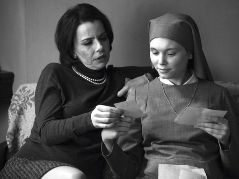 Polish-born director Pawel Pawlikowski has spent most of his life in England, and his films often explore the intersection of East and West in modern life. His new film Ida takes place in Poland in the early 1960s—and with the eye of both a native and an exile the director examines that country’s tragic legacy and its spiritual and emotional conflicts. Yet the style is delicate, poetic, almost fragile.
Polish-born director Pawel Pawlikowski has spent most of his life in England, and his films often explore the intersection of East and West in modern life. His new film Ida takes place in Poland in the early 1960s—and with the eye of both a native and an exile the director examines that country’s tragic legacy and its spiritual and emotional conflicts. Yet the style is delicate, poetic, almost fragile.
Anna is a nun novitiate, an orphan who has spent her life in a convent and is now, at age 18, preparing to take her vows. But first, the Mother Superior tells her that a relative has popped up, an aunt named Wanda, and Anna is told she needs to visit her. Wanda turns out to be a judge, a once proud political operative for the Communist state, now turned weary and cynical. And she has some startling news. Anna’s parents were Jews who were murdered during the war, and Anna’s birth name was Ida, Ida Lebenstein.
Despite her arrogant and bemused attitude regarding her niece’s Christianity, Wanda sees in her the image of her beloved dead sister. She takes Anna with her to the town where she grew up. The purpose is to find out about more about their family, and how they died. The people who now live in their house, one of the many families who took property from Jews after the Germans occupied the country, want the past to stay buried, of course. Anna, the nun, sweet and quiet, inspires their trust, but it’s the abrasive aunt who needs to throw her weight around to get real answers. Meanwhile they run into a young saxophone player who performs at a nearby nightclub, and his interactions with Anna gently contrast the younger generation’s stirring hopes at that time with the austerity of the young nun’s religious path.
In the role of Anna, or Ida, the nun who discovers she is Jewish, Pawlikowski has cast a newcomer, Agata Trzebuchowska, who has a beautiful wide-eyed stillness and is marvelous at portraying her character’s naïvete and hesitation. The aunt, Wanda, is played by another Agata, veteran character actor Agata Kulesza, whose chain-smoking and bitter sarcasm masks some very deep hurts from the past. With this brilliant pairing of old and new, experience and innocence, the story gradually unwraps the secrets of these two women’s lives.
The picture is shot in gorgeously crisp black-and-white, and it ends up demonstrating why this is sometimes the perfect choice instead of color. The images convey a sense of desolation and absence, in line with the feeling of grief and loss that color could never have achieved, and you end up really remembering the look of the film as much as the story. The screen is also traditionally square rather than widescreen, prompting one to think that this film looks like it could have been made during the time it’s set—in the early 60s.
The drama is not in the usual mode of Holocaust memory, but rather a tension between the allure of life in the world, offering the young woman new possibilities, and the desire to renounce it in order to find some kind of peace. This finely crafted film is devoted to witnessing a soul as it awakens.

